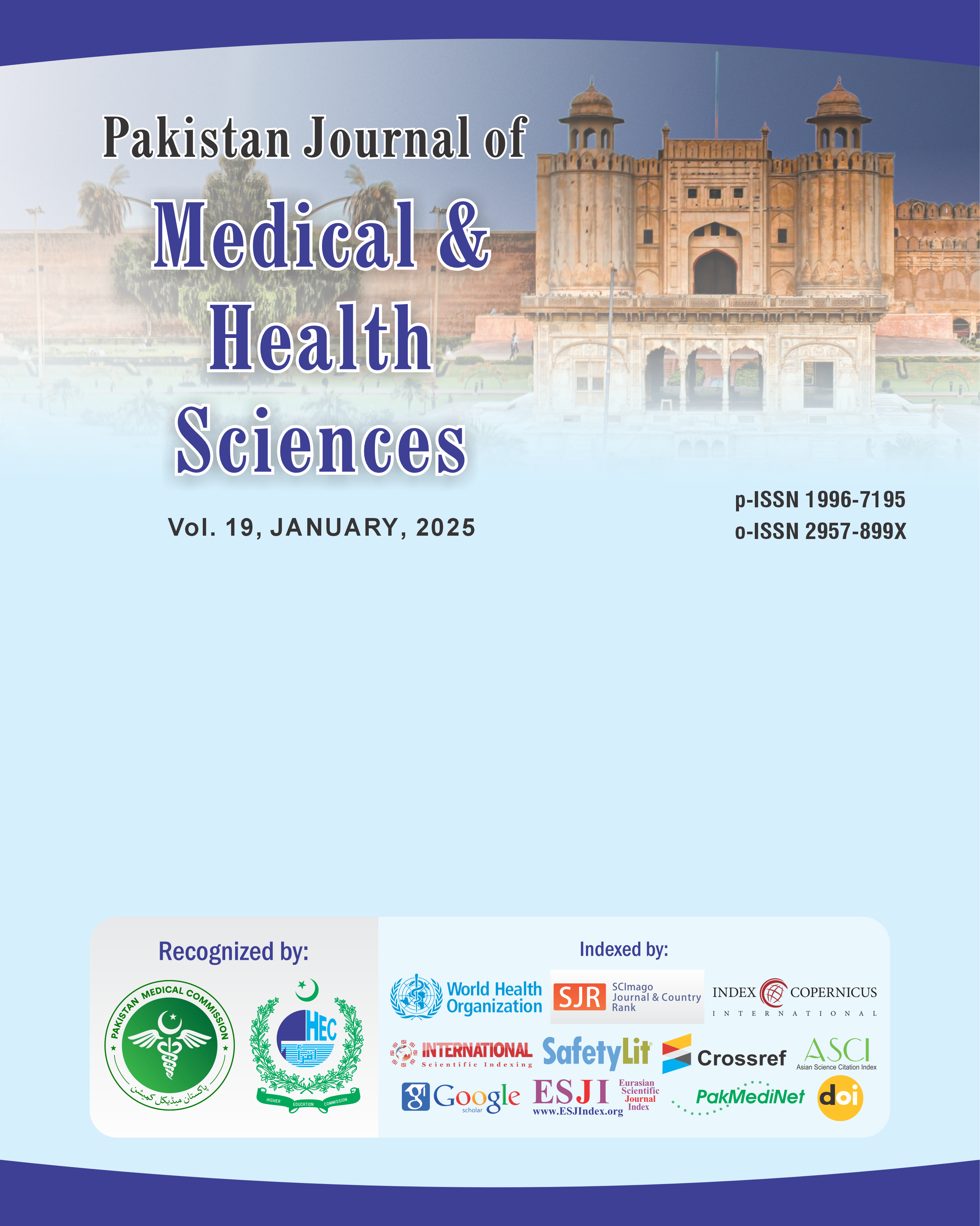Frequency of Anemia among Primary School Children in Lahore, Pakistan: A Cross-Sectional Study
DOI:
https://doi.org/10.53350/pjmhs02025191.2Keywords:
Anemia, Primary School Children, Hemoglobin, Nutritional Deficiency, Socioeconomic Status, Lahore, Pakistan, Cross-sectional StudyAbstract
Background: Anemia is one of the most common and yet most neglected public health problems among school-aged children in developing countries, including Pakistan. It results in tremendous repercussions for growth, cognition, academic performance, and, in general, health.
Aim: To find out the frequency and severity of anemia among primary school children of Lahore and to evaluate the association between anemia and demographic, nutritional, and socioeconomic factors.
Methods: This was a cross-sectional study conducted from 1st January 2024 and 31st October 2024 in selected public and private schools of Lahore. There were included through stratified random sampling a total of 80 children aged from 6 to 12 years from Grades 1 to 5. Data from demographic indicators, socioeconomic status, dietary patterns, and BMI were recorded. Measurements of hemoglobin levels were made using an automated hematology analyzer. The definition of anemia was according to the WHO guidelines. SPSS version 26.0 was used for statistical analysis.
Results: Of 80 children, 42(52.5%) were found to be anemic. There was 38.75 percent of moderate anemia, 13.75 percent of mild anemia, with no case of severe anemia. Children from lower-income households (65%), underweight children (65.4%), and in lower grades (Grade 1 and 2) were more anemic. Prevalence was slightly higher in the female students (55%) as compared to males (50%).
Conclusion: Anemia is highly prevalent in primary school children of Lahore, particularly in younger age, undernourished school children, and socioeconomically disadvantaged families. There is an urgent need for immediate public health interventions such as school-based nutritional education, iron supplementation, and awareness programs to alleviate this burden and to promote child health.
References
Habib MA, Black K, Soofi SB, Hussain I. Prevalence and predictors of iron deficiency anemia in children under five years of age in Pakistan , a secondary analysis of national nutrition survey data 2011 – 2012. PLoS One. 2016;11(5):1–13.
Subramaniam G, Girish M. Iron deficiency anemia in children. Indian J Pediatr. 2015;82:558–64.
Jamali NH, Mahesar H, Bhutto MA. Prevalence of iron deficiency anaemia in school and college going students of district Shaheed Benazirabad Sindh Province, Pakistan. Open J Blood Dis. 2016;6(04):67–78.
Harding KL, Aguayo VM, Namirembe G, Webb P. Determinants of anemia among women and children in Nepal and Pakistan: An analysis of recent national survey data. Matern Child Nutr. 2018;14:e12478.
Khan F, Saeed K, Akhtar N, Zeb J, Ali H, Khan SA, et al. Anemia and iron deficiency anemia in school children of district Swat Khyber Pakhtunkhwa Pakistan. J Entomol Zool Stud. 2016;4(5):366–8.
Ahmad MS, Farooq H, Maham SN, Qayyum Z, Waheed A, Nasir W. Frequency of anemia and iron deficiency among children starting first year of school life and their association with weight and height. Anemia. 2018;2018.
Din JU, Yousafzai AM, Khan RA, Ullah M, Khan SU, Khan S, et al. Iron deficiency anaemia in school age children of District Tank Khyber Pakhtunkhwa Province, Pakistan. Children. 2019;
Martin J. Joanna Briggs Institute 2017 Critical Appraisal Checklist for Systematic Reviews and Research Syntheses. JBI Adelaide, Aust. 2017;
Ullah I, Afridi K, Afridi H, Riaz B, Sheikh GALI. Frequency of iron deficiency anemia in children : cross- sectional survey of outpatients at Akhtar Saeed Trust teaching hospital , Lahore from 2016-17. Pakistan J Med Heal Sci. 2017;11(4):1365–8.
Akhtar S. Malnutrition in South Asia—a critical reappraisal. Crit Rev Food SciNutr. 2016;56(14):2320–30.
Habib MA, Black K, Soofi SB, Hussain I, Bhatti Z, Bhutta ZA, et al. Prevalence and predictors of iron deficiency anemia in children under five years of age in Pakistan, a secondary analysis of national nutrition survey data 2011–2012. PLoS One. 2016;11(5).
Abdullah M, Mahmood S, Ahmed Z. Evaluation of anti anemic prospective of natural iron sources in lactating women-an ignored important segment of Pakistani population. Food Sci Technol. 2020;41:453–60.
Kallio H, Pietilä A, Johnson M, Kangasniemi M. Systematic methodological review: developing a framework for a qualitative semi‐structured interview guide. J AdvNurs. 2016;72(12):2954–65.
Gill P, Stewart K, Treasure E, Chadwick B. Methods of data collection in qualitative research: interviews and focus groups. Br Dent J. 2008;204(6):291–5.
Gill P, Baillie J. Interviews and focus groups in qualitative research: An update for the digital age. Br Dent J. 2018;225(7):668–72.
Naderifar M, Goli H, Ghaljaie F. Snowball sampling: A purposeful method of sampling in qualitative research. Strides Dev Med Educ. 2017;14(3).
Ahmed A, Ahmad A, Khalid N, David A, Sandhu MA, Randhawa MA, et al. A question mark on iron deficiency in 185 million people of Pakistan: its outcomes and prevention. Crit Rev Food SciNutr. 2014;54(12):1617–35.
Khor GL. Update on the prevalence of malnutrition among children in Asia. Nepal Med Coll J. 2003;5(2):113–22.
Khan MA. Pakistan Poverty Reduction Policies And Programmes: Impact On Poverty And Nutrition. Program Impact Poverty Nutr. :144.
Rahman AU, Zahid M, Ali A. Iron deficiency anemia (IDA) in preschool children of district Dir Lower Khyber Pakhtoonkhwa Pakistan. Pure Appl Biol. 2019;8(1):1–8.
Downloads
How to Cite
Issue
Section
License
Copyright (c) 2025 MUZNA KASHIF, GUL E NASREEN, MUHAMMAD NASIR SHAHBAZ, MUHAMMAD ASAWIR IMRAN, ASFAND YAR MUJAHID, MUHAMMAD ARHAM RAUF

This work is licensed under a Creative Commons Attribution 4.0 International License.


